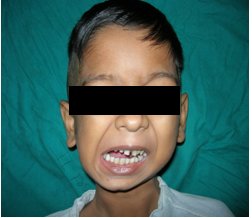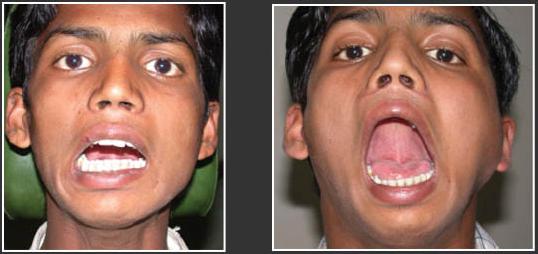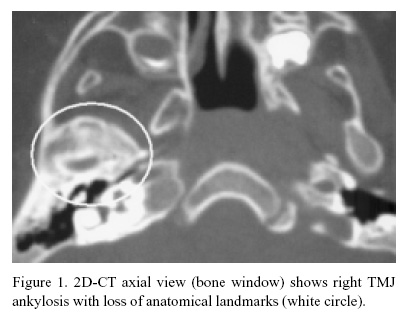 Temporomandibular Joint Ankylosis is the Hypomobility condition caused due to the fusion of the TMJ. This fusion of the joint leads to the stiffening and fixation of the joint at a particular position. This happens due to either the fusion of the bones in the joint, or else due to the formation of calcium deposits around the TMJ ligaments, and this can happen on either one side or both the sides. The ankylosis of the TMJ is of 2 types, i.e. True and False, which would be discussed further below. They are distinguished based on the position and the causing factor of the ankylosis, and the way the immobility of the Temporomandibular joint has occurred. Most of the time, the condition is chronic and painless, but sometimes the TMJ ankylosis may cause a little pain depending on the cause of the ankylosis, and while opening of the mouth.
Temporomandibular Joint Ankylosis is the Hypomobility condition caused due to the fusion of the TMJ. This fusion of the joint leads to the stiffening and fixation of the joint at a particular position. This happens due to either the fusion of the bones in the joint, or else due to the formation of calcium deposits around the TMJ ligaments, and this can happen on either one side or both the sides. The ankylosis of the TMJ is of 2 types, i.e. True and False, which would be discussed further below. They are distinguished based on the position and the causing factor of the ankylosis, and the way the immobility of the Temporomandibular joint has occurred. Most of the time, the condition is chronic and painless, but sometimes the TMJ ankylosis may cause a little pain depending on the cause of the ankylosis, and while opening of the mouth.
Table of Contents:
Etiology / Causes of TMJ Ankylosis
Signs and Symptoms of TMJ Ankylosis
Types of TMJ Ankylosis
Radiographic features of TMJ Ankylosis
Treatment of TMJ Ankylosis
Causes of TMJ Ankylosis
The most common causes of the Ankylosis are the traumatic injuries and infections in and around the joint. The main causes for the Ankylosis of the Temporomandibular joint are –
- Abnormal intrauterine development (Development of the child in the womb happens in an abnormal manner)
- Birth Injury (Delivery using forceps injuring the TMJ)
- Trauma to the chin (leading the condyle forcing into the glenoid fossa, particularly with bleeding into the joint space)
- Trauma to the joint during any accident or fall
- Malunion of condylar fractures
- Congenital defect – From the birth
- Injury associated with the fracture of the Malar-zygomatic compound
- Primary inflammation of the joint i.e. e.g. Rheumatoid Arthritis
- Inflammation of the joint secondary to local inflammation e.g. mastoiditis, osteomyelitis of temporal bone
- Inflammation of the joint secondary to infection in the blood stream e.g. Septicemia
- Inflammation of the joint secondary to Radiotherapy
- Secondary to any occurrence of tumor in TMJ area
- Metastatic malignancies
- Enlargement of the Coronoid process
- Surgery done in or around the joint
- Destruction of the TMJ cartilage
Ankylosis when occurred in children whose jaws are still in the phase of growth, would restrict the growth of the mandible and in the X-rays it is shown that the TMJ ankylosis has shown a deformity in the growth of the mandible due to the Temporomandibular joint ankylosis.
Signs and Symptoms of TMJ Ankylosis
The problems that arise with the TMJ Ankylosis are psychological, morphological, Aesthetic and functional. The restricted function of the joint would affect the jaw movement, and the patient also suffers psychological problems due to the same. Below are a few features seen clinically in patients with TMJ Ankylosis –
- Restricted movements of the jaw, the mandible due to the condyle fusion in the TMJ
- Inadequate chewing function
- Restricted mouth opening
- Poor maintenance of oral hygiene
- In severe cases, problems in speech
- In children, reduced growth of mandible results in “Bird Face”
- If single side is affected, facial asymmetry is seen
- Misaligned teeth, due to lack of enough space in the jaws
- Emotional, social, psychological disturbances
If any motion is present in the jaws, while trying to open the mouth the chin deviates towards the side which is ankylosed. In children, the chin is also underdeveloped and receding chin is seen with micrognathia. Overjet due to the maxillary anterior teeth is seen as mandibular growth is less. The severity of the condition is checked by the dentist or practitioner by checking the range of mouth opening i.e. how wide the patient is opening the mouth, the deviation while opening the mouth and whether the patient is feeling discomfort while trying to open their mouth.
Types of TMJ Ankylosis
The Temporomandibular Joint Ankylosis is divided into 2 types – True and False.
The True ankylosis is the Intra-articular ankylosis and the False ankylosis is the Extra-articular ankylosis.
The True ankylosis is a dangerous type which causes severe psychological and physical disturbances. It is caused due to many reasons and is the one which causes severe problems to the movement of the jaw, the development of mandible and the chin, and this may be unilateral or bilateral. The “Bird Face” appearance is seen due to true bilateral congenital Ankylosis of the TMJ.
The False ankylosis is caused due to the enlargement of the coronoid process, or the depressed fracture of the zygomatic arch, scarring from surgery, irradiation or infection.
The signs and symptoms of the true ankylosis are more relevant and prominent when compared to the false ankylosis.
Radiographic features of TMJ Ankylosis
Radiographic examination is also an important part in the clinical assessment and diagnosis of the TMJ Ankylosis. Although there are no specific radiographic features seen, the joint still would show an irregularly shaped condyle of the mandible, and even there is a dense bone filling in the joint space which is indicative of the restricted movement of the mandible.
Treatment of TMJ Ankylosis
There are various treatment procedures for the TMJ Ankylosis and this condition can be corrected using different surgical and non-surgical methods.
- Excision of the Ankylosis via Gap Arthroplasty
- Arthroplastic procedures not involving the replacement with autogenous, alloplastic or allogenic material
- If the Ankylosis is intra-articular and the coronoid process is involved, the Condylectomy is done, and if the the coronoid process along with the zygomatic arch are involved, the osteotomy of the coronoid process along with a part of the ramus is done.
- Total condylectomy followed by the replacement of the joint using autogenous, alloplastic, allogenic material.
If the condition is unilateral, the treatment is not as complex as that of the bilateral ankylosis, because the bilateral has not just the problem of the joint but also the development of the jaw and chin is affected and that needs to be corrected.
Apart from the above surgical procedures, there is therapeutic treatment given, which includes the Bisphosphonates, NSAIDs, and the practice of physiotherapy by jaw exercises after the condition is treated, to prevent the reankylosis of the TMJ. To maintain a good and continuous mouth opening, the jaw exercises are done for around 1-2 years after the treatment.
The facial asymmetry is to such an extent in bilateral cases, that one needs to get orthognathic surgery done to correct it. The orthognathic procedures include the Sagittal split osteotomy, genioplasty, Extended-sliding genioplasty etc. where the reduced chin is brought forward to make it esthetically better.


Sir i have the problem of tmj ankylosis can you show me the treat ment i have right side tmj ankylosis
Sir i have the problem of tmj ankylosis can you show me ….where i treatment.
please give me….address,
i have left side anklylosis…………..please sir,
Sir i have the problem of tmj ankylosis can you show me ….where i treatment.
please give me….address,
i have left side anklylosis…………..please sir,
Sir, I have suffered from true tmj ankylosis for 11 years now due to no money for treatment. I’m getting worse every year
My mouth cannot open to even half a centimeter. Please can you link me with any philanthropic movement that can fund my treatment? It is more than traumatizing
I am suffering from left sided ankylosis. I have pain with severe pressure in my ear which causing dizziness. I need a physician that has experience and can give me guidance on the next step. Thanks in advance for any advice.